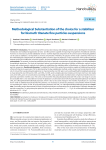Building materials science. Рубрика в журнале - Nanotechnologies in Construction: A Scientific Internet-Journal

Статья научная
Introduction. The current stage of the construction industry and building materials science development involves the introduction and widespread application of nano- and fine particles capable of improving the properties of traditional materials. However, it is necessary to provide stabilization of nano- and fine-dispersed components in the cement system. Plasticizing additives can be used as stabilizers. It is important to set their concentration. Therefore, the purpose of this study is outlined, which lays in the methodological substantiation the stabilizing effect of various types of plasticizers on the suspension of fine synthetic bismuth titanate used in the modification of cement systems, and the establishment of the limits of their optimal concentrations. Materials and methods. The research is aimed at establishing the limits of optimal concentrations of polycarboxylate and sulfonaphthalene formaldehyde plasticizers. The limits of plasticizers optimal concentrationsis determined withdye solubilization method, surface tension and conductometric methods, and studies on establishing the stabilizing effect of plasticizers on a bismuth titanate fine particles suspension. Results and discussion. To establish the limits of the optimal concentration capable of stabilizing fine particles of bismuth titanate in suspension, CMC is determined by the dye solubilization method, surface tension and conductometric methods. It is found that a polycarboxylate plasticizer is characterized by one CMC point, and a sulfonaphthalinformaldehyde plasticizer is characterized by two CMC points: CMC1 and CMC2. At CMC1 point unstable spherical micelles are formed, which turn into stable ones at the CMC2 point. At concentrations exceeding the CMC2 value, polymorphic transformations of spherical micelles into nonspherical asymmetric micelles occur. The same can be traced for the polycarboxylate plasticizer CMC only in one stage. It can also be concluded that it is not reasonable to increase the plasticizer concentration above CMC for polycarboxylate plasticizer and above CMC2 for sulfonaphthalinformaldehyde plasticizer, which is due to structural changes in the micelles of plasticizers. It is assumed that in order to stabilize bismuth titanate fine particles, it is necessary to choose the plasticizers concentration within the limits not exceeding the values of CMC for polycarboxylate plasticizer and CMC2 for sulfonaphthalinformaldehyde plasticizer. Conclusion. Concluding results demonstrate the limits of optimal plasticizers concentrations for the stabilization of bismuth titanate fine particles suspension. For polycarboxylate plasticizer this range of concentrations is 1.1 – 1.5 g/l; for sulfonaphthalinformaldehyde plasticizer its 2.2 – 4.0 g/l.
Бесплатно

